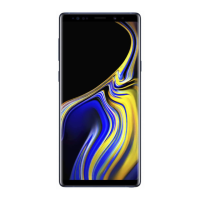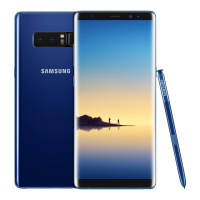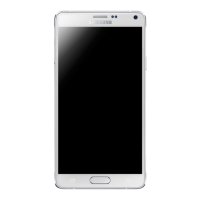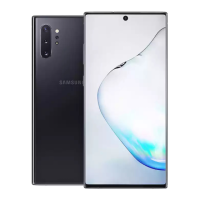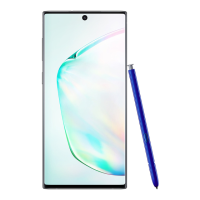Do you have a question about the Samsung Galaxy Note and is the answer not in the manual?
Details Samsung's warranty limitations and exclusions for the product.
Instructions for installing and charging the device battery.
Tips and methods to conserve battery power and extend usage.
Step-by-step guide for setting up the device for the first time.
Steps to create a Google account for device functionality.
Information on setting up and accessing voicemail services.
Details the functionality and use of the S Pen stylus.
The starting point for using applications, with customizable panels.
Procedure to mount the SD card for storing photos, music, and applications.
Instructions for erasing files from the SD card using the device.
Instructions on how to store and dial phone numbers.
Procedure for making emergency calls, with or without a SIM card.
How to answer or reject incoming calls.
Using voice recognition to activate device functions.
Setting up speed dial entries for quick dialing.
Making and receiving calls over an active Wi-Fi connection.
Information on making and managing multi-party or conference calls.
Assigning the desired text input method from settings or the notification panel.
Guide to entering text by sliding finger/stylus from letter to letter.
Using the QWERTY keyboard for text entry in Portrait or Landscape.
Utilizing XT9 for next-letter prediction and error correction.
Converting spoken words into text using Google voice recognition.
Saving phone numbers and managing contact entries.
Steps to create a new contact, save to phone, SIM, Google, or Corporate.
Searching for contacts by name or browsing the list.
Merging multiple account entries into a single contact record.
Copying contact information to SIM card or microSD card.
Syncing contact data from managed accounts to the phone.
Synchronizing data from social sites and email accounts to Contacts.
Step-by-step guide to creating and sending text messages.
How to add images, take pictures, record video, or add audio files.
Composing and sending a reply to a text message.
Deleting single message threads or multiple message threads.
Configuring settings for text, multimedia, voice, and push messages.
Reviewing and creating emails using multiple email services.
Configuring a corporate email account for synchronization.
Accessing and managing Gmail account, synchronization, and labels.
Instructions on taking photos with the device's built-in camera.
Instantly sharing a series of pictures as they are taken.
Using Wi-Fi Direct to connect devices and share pictures in real-time.
Using the Photo editor application for basic image tuning and effects.
Recording, viewing, and sending high definition videos.
Instructions for recording video using the camcorder mode.
Viewing photos and playing back videos, with basic editing tasks.
Playing video files stored on the SD card, including DivX videos.
Accessing, renting, or purchasing movie and TV content.
Steps to create a new account for renting or buying media.
Browsing movies and TV shows available for rent or purchase.
Connecting to Play Store to download and watch movies.
Browsing, shopping, and playing purchased songs from Play Store.
Wirelessly synchronizing phone content with TVs and other DLNA devices.
Accessing the internet using the Google browser.
Performing internet searches using keywords.
Quickly accessing frequently visited websites by bookmarking them.
Short-range communication technology for wireless device connection.
Setting up device name, visibility, and reviewing received files.
Establishing trusted connections between your device and other Bluetooth devices.
Enabling Unknown Sources to download non-Play Store applications.
Connecting the device to a PC using a data cable for various connection modes.
Connecting the device to a PC as a removable disk to access files.
Syncing your Windows PC wirelessly with your phone via Wi-Fi.
Information about Wi-Fi networks and connecting to Wireless Access Points.
Steps to connect to a detected Wi-Fi network.
Sharing device data connection via USB to a computer.
Turning the device into a Wi-Fi HotSpot for internet connectivity.
Describes Wi-Fi settings for connectivity and advanced options.
Steps to activate Wi-Fi to discover and connect to networks.
Adding a new network connection manually by entering SSID and security.
Activating Bluetooth, viewing device names, and scanning for devices.
Monitoring data usage, setting limits, and viewing application data.
Using phone features while calls or data access are prohibited.
Connecting device to PC via USB cable for mass storage mode.
Steps to establish and configure a VPN connection.
Configuring device to make/receive calls over Wi-Fi connection.
Setting preferences for Wi-Fi Calling feature like Wi-Fi Preferred.
Sharing mobile data via USB or creating a Wi-Fi HotSpot.
Configuring device connection with other Wi-Fi Direct devices.
Activating data usage on the phone.
Configuring general call settings like rejection and answering options.
Managing call rejection mode, auto reject list, and caller ID.
Setting up call forwarding options like always forward or forward when busy.
Changing font, orientation, notifications, brightness, and power saving.
Automatically setting power saving mode and configuring options manually.
Synchronizing data from various sources like Google, Facebook, and email.
Configuring device location services for Google Maps and other apps.
Configuring device security parameters like screen unlock.
Resetting phone to factory defaults, backing up settings and data.
Resets phone and sound settings to factory defaults, erasing data.
Explains SAR limits and FCC certification for wireless mobile phones.
Guidelines for safe mobile device use while driving.
Important precautions for handling and storing batteries properly.
Operation of mobile device for essential communications.
Recommendations for using portable audio devices to avoid hearing loss.
Details what is covered and for how long under the warranty.
Lists conditions and damages not covered by the limited warranty.
Procedure for obtaining warranty service, including required documentation.
| Panel type | AMOLED |
|---|---|
| Display diagonal | 5.29 \ |
| Display resolution | 800 x 1280 pixels |
| Display number of colors | 16.78 million colors |
| Ringer type | Polyphonic |
| Orientation sensor | - |
| Processor frequency | 1.4 GHz |
| Maximum memory card size | 32 GB |
| Internal storage capacity | 16 GB |
| Flash type | LED |
| Photo effects | Negative film, Sepia |
| White balance | Auto, Cloudy, Daylight, Fluorescent, Incandescent |
| ISO sensitivity | 100, 200, 400, 800, Auto |
| Front camera type | Single camera |
| Maximum frame rate | 30 fps |
| Video capture resolution (max) | 1920 x 1080 pixels |
| Rear camera resolution (numeric) | 8 MP |
| Front camera resolution (numeric) | 2 MP |
| 2G standards | EDGE, GPRS |
| 3G standards | HSPA, WCDMA |
| Data network | 3G |
| Wi-Fi standards | 802.11a, 802.11b, 802.11g |
| Bluetooth version | 3.0+HS |
| 3G bands supported | 800, 850, 900, 1900 MHz |
| Bluetooth profiles | A2DP, AVRCP, GAP, HFP, HID, HSP, MAP, OPP, PBAP, SAP, SDAP, SPP, SSP |
| SIM card capability | Single SIM |
| 2G bands (primary SIM) | 850, 900, 1800, 1900 MHz |
| Audio formats supported | AAC, AMR, MP3 |
| Image formats supported | JPG |
| Video formats supported | 3GP, H.263, H.264, MPEG4, WMV |
| USB version | 2.0 |
| HDMI ports quantity | 0 |
| USB 2.0 ports quantity | 1 |
| Form factor | Bar |
| Product color | Black |
| Platform | Android |
| App distribution platform | Google Play |
| Operating system installed | Android 2.3 |
| Personalization | Themes |
| Personal info management (PIM) | Alarm clock, Calculator, Calendar, Countdown timer, Stopwatch, To-do list |
| Body SAR (EU) | 0.615 W/kg |
| Head SAR (EU) | 0.209 W/kg |
| Specific absorption rate (SAR) value (EU) | 0.256 W/kg |
| Text prediction system type | T9 |
| Multimedia Messaging Service (MMS) | Multimedia Messaging Service (MMS) is a standard way to send messages that include multimedia content to and from a mobile phone over a cellular network |
| Talk time (2G) | 26.1 h |
| Talk time (3G) | 13.5 h |
| Battery capacity | 2500 mAh |
| Standby time (2G) | 960 h |
| Standby time (3G) | 820 h |
| Depth | 9.65 mm |
|---|---|
| Width | 82.95 mm |
| Height | 146.85 mm |
| Weight | 178 g |

